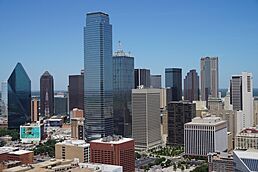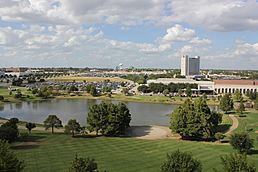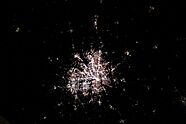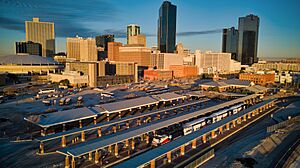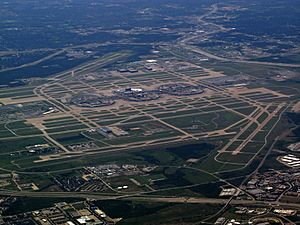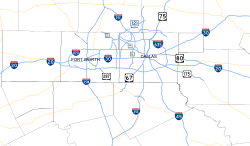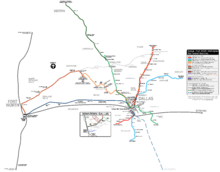Dallas–Fort Worth metroplex facts for kids
Quick facts for kids
Dallas–Fort Worth Area
|
|
|---|---|
| Dallas–Fort Worth–Arlington, TX Metropolitan Statistical Area |
|
|
From top: Dallas, Fort Worth, Arlington, showcasing Downtown Dallas and Downtown Fort Worth, and the Arlington Entertainment District
|
|
| Country | United States |
| State | Texas Oklahoma |
| Principal cities | |
| Area | |
| • Urban | 1,746.90 sq mi (4,524.44 km2) |
| • Metro | 8,675 sq mi (22,468 km2) |
| Highest elevation | 1,368 ft (417 m) |
| Population
(2020 census)
|
|
| • Conurbation | 7,637,387 (4th) |
| • Urban | 5,732,354 (6th) |
| • Urban density | 3,281.45/sq mi (1,266.98/km2) |
| • Metro density | 880.4/sq mi (339.9/km2) |
| • MSA | 7,637,387 (4th) |
| • CSA | 8,121,108 (7th) |
| GDP | |
| • MSA | $688.928 billion (2022) |
| Time zone | UTC-6 (CST) |
| • Summer (DST) | UTC-5 (CDT) |
| Area codes | 214, 430, 469, 682, 817, 903, 940, 945, 972 |
The Dallas–Fort Worth metroplex is a huge area in Texas. It is often called DFW or the Metroplex. This area includes the big cities of Dallas and Fort Worth, plus many other towns. It is the most populated area in Texas and the southern United States.
About 7.6 million people lived here in 2020. This makes it the fourth-largest metropolitan area in the U.S. By 2023, the population grew to over 8.1 million people. This was the biggest growth of any metropolitan area in the U.S.
The economy here is very strong. It is sometimes called "Silicon Prairie" because of its focus on technology. Many large companies have their main offices in DFW. This includes banking, insurance, and healthcare. It is also a major center for transportation and logistics.
DFW has many colleges and universities. It also has a large number of churches.
Contents
What is the Metroplex?
The word "metroplex" combines "metropolis" (a large city) and "complex" (a group of connected things). This term was created in 1972 to help people recognize the Dallas-Fort Worth area. Before that, people just called it "North Texas." But that name was confusing because other parts of Texas are also in the north.
Geography of DFW
The Dallas–Fort Worth Metroplex is a very large area. It covers about 9,286 square miles (24,051 square kilometers). This is bigger than the states of Rhode Island and Connecticut combined! Most of the land is flat prairie with some rolling hills. There are also many human-made lakes, streams, and rivers.
The eastern part of DFW has very fertile black soil. This is great for farming. The western part has rockier soil, which is better for ranches. Underneath this area, there is a large natural gas field called the Barnett Shale.
Metroplex Counties
The Dallas–Fort Worth–Arlington area is made of two main parts. These are called metropolitan divisions.
Dallas–Plano–Irving Division
Fort Worth–Arlington–Grapevine Division
DFW Climate
DFW has a humid subtropical climate. This means summers are very hot and humid. July and August are usually the hottest months. Temperatures often reach over 96°F (36°C). The highest temperature ever recorded was 113°F (45°C) in 1980.
Winters are cool to mild. January is the coldest month, with average highs around 57°F (14°C). Sometimes, strong cold fronts called "Blue Northers" bring much colder weather. Snow falls in DFW about 70% of winters, but usually only a small amount.
Major Cities in DFW
Here are some of the main cities and towns in the Dallas–Fort Worth area. The cities marked with an asterisk (*) are not officially counted as cities but are still important places.
Cities with Over 100,000 People
The "principal cities" are shown in bold italic.
Over 1,000,000 People
- Dallas (1,299,544)
500,000–999,999 People
- Fort Worth (956,709)
200,000–499,999 People
- Arlington (394,602)
- Plano (289,547)
- Irving (254,715)
- Garland (240,854)
- Frisco (219,587)
- McKinney (207,507)
- Grand Prairie (201,843)
100,000–199,999 People
- Denton (150,353)
- Mesquite (147,899)
- Carrollton (133,820)
- Lewisville (131,215)
- Richardson (118,802)
- Allen (111,551)
DFW's Economy
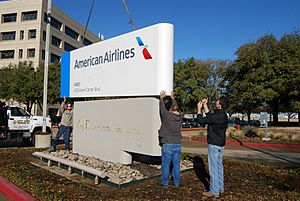
Dallas and Fort Worth are the two main cities for business. Arlington is also important for sports, tourism, and making things. Many other cities in the Metroplex are "bedroom communities." This means people live there and travel to bigger cities for work.
The DFW area is a major business center. It has the third-highest number of company headquarters in the U.S. Many big companies have moved their main offices here. This includes companies like McKesson and Charles Schwab.
Banking and finance are also very important. DFW is the second-largest financial hub in the U.S., after New York City. Big banks like Bank of America and JPMorgan Chase have large offices here.
The area is also known for its technology industry. It is sometimes called "Silicon Prairie." Many tech companies like Microsoft, Samsung, and Google have offices here. AT&T, a huge phone company, has its main office in Dallas. ExxonMobil, a large energy company, is in Irving. American Airlines, the world's biggest airline, has its main office in Fort Worth. They are the largest employer in the Metroplex.
Sports in DFW
DFW is one of the few U.S. areas with teams in all four major professional sports. These sports are football, baseball, basketball, and hockey.
Major Professional Sports Teams
| Club | Sport | Founded | League | Venue |
|---|---|---|---|---|
 Dallas Cowboys |
American Football | 1960 | NFL | AT&T Stadium |
 Texas Rangers |
Baseball | 1972^ | MLB | Globe Life Field |
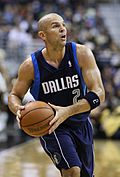 Dallas Mavericks |
Basketball | 1980 | NBA | American Airlines Center |
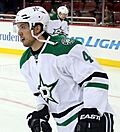 Dallas Stars |
Ice Hockey | 1993^ | NHL | American Airlines Center |
 FC Dallas |
Soccer | 1996 | MLS | Toyota Stadium |
 Dallas Wings |
Basketball | 2015^ | WNBA | College Park Center |
Panther City Lacrosse Club |
Lacrosse | 2020 | NLL | Dickies Arena |
Texas Super Kings |
Cricket | 2023 | MLC | Grand Prairie Stadium |
^- Indicates year team relocated to the area
College Sports Teams
DFW is home to several colleges with Division I sports teams.
| School | City | Mascot | Conference |
|---|---|---|---|
 University of Texas at Arlington |
Arlington | Mavericks | Western Athletic Conference |
 University of North Texas |
Denton | Mean Green | American Athletic Conference |
 Southern Methodist University |
University Park | Mustangs | American Athletic Conference (Atlantic Coast Conference in 2024) |
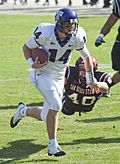 Texas Christian University |
Fort Worth | Horned Frogs | Big 12 Conference |
 Texas A&M University–Commerce |
Commerce | Lions | Southland Conference |
 Dallas Baptist University |
Dallas | Patriots | Missouri Valley Conference (baseball only) |
Education in DFW
DFW has many colleges and universities. The UT Southwestern Medical Center is a top medical school. It has been home to six Nobel Prize winners.
Public Universities
| School | Enrollment | Location | Mascot | Athletic affiliation (conference) |
University system |
|---|---|---|---|---|---|
 University of North Texas |
46,940 | Denton | Mean Green | NCAA Division I FBS (American Athletic Conference) |
University of North Texas System |
 University of Texas at Arlington |
42,496 | Arlington | Mavericks | NCAA Division I (WAC) Non–Football |
University of Texas System |
 University of Texas at Dallas |
31,570 | Richardson | Comets | NCAA Division III (American Southwest) Non–Football |
University of Texas System |
 Texas Woman's University |
15,472 | Denton | Pioneers | NCAA Division II (Lone Star) Women's sports only |
Independent |
 Texas A&M University–Commerce |
12,385 | Commerce | Lions | NCAA Division I FCS (Southland) |
Texas A&M University System |
 University of North Texas at Dallas |
3,030 | Dallas | Trailblazers | NAIA (Sooner) Non–Football |
University of North Texas System |
 UT Southwestern |
2,235 | Dallas | N/A | N/A | University of Texas System |
Private Universities
| School | Enrollment | Location | Mascot | Athletic affiliation (conference) |
|---|---|---|---|---|
 Southern Methodist University |
11,643 | University Park | Mustangs | NCAA Division I FBS (American; ACC in 2024) |
 Texas Christian University |
10,394 | Fort Worth | Horned Frogs | NCAA Division I FBS (Big 12) |
 Dallas Baptist University |
5,445 | Dallas | Patriots | NCAA Division II (Lone Star) Non–Football, compete in the Missouri Valley Conference at the Division I level for baseball |
 Texas Wesleyan University |
3,378 | Fort Worth | Rams | NAIA (Sooner) |
 University of Dallas |
2,387 | Irving | Crusaders | NCAA Division III (SCAC) Non–Football, compete in Texas Rugby Union at the Division II level for Rugby |
 Southwestern Assemblies of God University |
2,012 | Waxahachie | Lions | NAIA NCCAA (Sooner and Central States Football League) |
 Paul Quinn College |
600 | Dallas | Tigers | NAIA (Red River) Non–Football |
Media in DFW
Dallas and Fort Worth each have their own newspapers. These are The Dallas Morning News and the Fort Worth Star-Telegram. Many people in the area read both papers.
DFW is the fifth-largest television market in the U.S. This means many people watch TV here. There are also many radio stations. Some powerful AM radio stations, like 820 WBAP and 1080 KRLD, can be heard across North America at night.
Transportation in DFW
Air Travel
The Dallas Fort Worth International Airport (DFW) is a very large and busy airport. It is located between Dallas and Fort Worth. It is the biggest airport in Texas and one of the largest in the world. Many people travel through DFW each year. American Airlines has its main office next to DFW.
The Dallas Love Field Airport (DAL) is in northwest Dallas. Southwest Airlines has its main office next to Love Field.
Freeways
The DFW area has many miles of freeways. Most of these roads have "access roads" next to them. Businesses are often located on these access roads.
Major highways running north to south include I-35 and I-45. I-35 splits into two parts: I-35E goes through Dallas, and I-35W goes through Fort Worth.
Highways running east to west include I-30 and I-20. I-30 connects Dallas and Fort Worth. I-20 goes around the south side of both cities.
Many new road projects are happening to help with traffic. Some of these new roads are tollways, meaning you have to pay to use them.
Public Transit
Public transportation is growing in DFW. Dallas Area Rapid Transit (DART) offers bus and light rail service in Dallas County and parts of Collin and Rockwall counties. DART's rail system is very long, covering 93 miles.
The Denton County Transportation Authority (DCTA) provides bus service in Denton, Highland Village, and Lewisville. It also has the A-train, a commuter train that connects these cities to Carrollton. From Carrollton, you can switch to the DART Green Line.
Trinity Metro (formerly 'The T') offers bus service in Fort Worth. It also runs TEXRail, a commuter train from downtown Fort Worth to DFW Airport. The Trinity Railway Express (TRE) is another commuter train. It connects downtown Fort Worth to downtown Dallas. You can also get to DFW Airport from a TRE station using a shuttle bus.
Amtrak trains stop at two stations in DFW: Dallas Union Station and Fort Worth Central Station.
Images for kids
See also
 In Spanish: Dallas-Fort Worth metroplex para niños
In Spanish: Dallas-Fort Worth metroplex para niños


